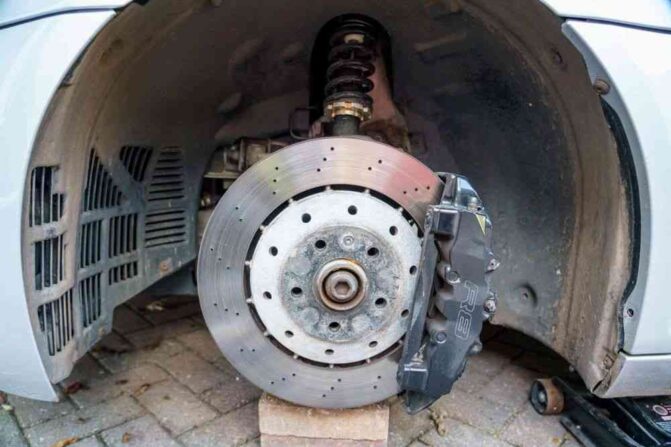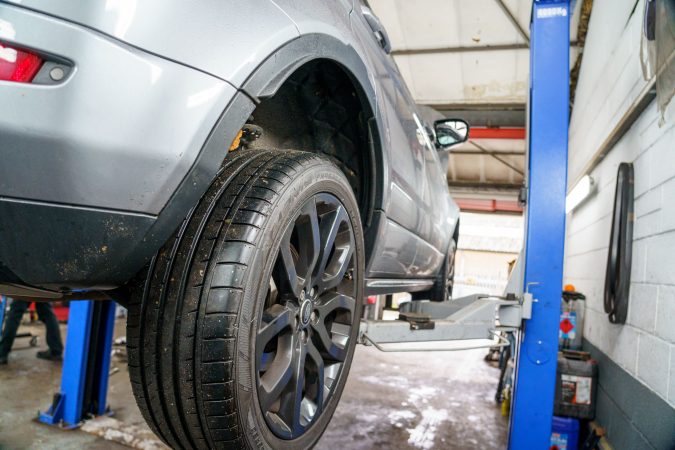Ever wondered why you’ve not bumped your head on the roof every single time you drive over a speedhump? Well, you can thank your car’s clever suspension for that. Not only does it need to cushion your body (as well as the rest of the car) from all that shaking, but it also needs to make sure you don’t bounce around too much. Understandably then, shocks and struts replacement cost isn’t something that can be easy on your wallet.
But pay you must, and it’s more than just your discomfort that is at stake. Shocks and struts are among the most crucial components in your car’s suspension. And there are indeed many bits and pieces that co-exist within an automotive suspension system. You can imagine then, that having your entire car, with its many hundreds or thousands of moving parts – all of which need to work within very tight tolerances – bouncing around and swaying about isn’t a good idea.
But what exactly are shocks and struts, and what do they do? Aren’t shocks and struts the exact same thing? More importantly, if they’re so integral to your car’s well-being, how could they possibly wear out? How can I tell if my shocks or struts need to be replaced? Moreover, how much am I going to have to pay for all this? All very pertinent questions, and ones which we’ll hope to answer in our shocks and struts replacement cost guide…
- What Are Shocks & Struts?
- Causes For Worn Shocks & Struts
- Symptoms Of Bad Shocks Or Struts
- Average Replacement Costs
- Prevention & Maintenance Tips
- Final Conclusion
- Frequently Asked Questions (FAQs)
Struts vs Shocks
Shocks and struts both perform similar roles in your car’s suspension. Therefore, a lot of people have made the mistake of using them interchangeably. However, it’s important to understand that they are both different components in their design and structure. So, it’s not a good idea to tell your mechanic to check your car’s “struts”, when you actually meant “shocks”. As the name may have suggested, struts (unlike shocks) are structural components in a car’s suspension.
It’s the struts that are what hold the coil springs in place. As they are an integral component in your car’s suspension structure, the struts are also a part of your car’s steering. The struts share responsibility for maintaining the wheel alignment, as one example. It’s for this reason why – as we’ll learn later on in our shocks and struts replacement cost guide – damage to your struts can be felt quite easily through the steering.
Difference Between Shocks And Struts
Since they play such a pivotal role, struts can also be expensive to replace. The main role of shocks – or ‘shock absorbers‘ – on the other hand, is to help cushion your car. But even more crucially, shocks also control and moderate the level of the bounciness of your car’s suspension. The coil springs – or just the springs – in your car’s suspension is what absorb most of the impact and movement. However, it’s the shocks that prevent them from bouncing too much.
Imagine if you’re jumping up and down a trampoline… We don’t want this on a car. That is what happens when you don’t have the shocks. Filled with pressurized gas or hydraulic fluid, shocks are cylindrical tubes that work like pistons. With this in mind, shocks are then able to provide the right amount of resistance against the coil springs extending or compressing too much. In effect, it makes sure your car doesn’t jiggle like a bouncy ball every time it goes over a speed hump.
How Long Do Shocks And Struts Last
So far then, we can understand that your car’s shocks and struts have a lot of key roles to play. But surely if they’re this important, they shouldn’t be able to wear out, right? Well, it’s not as simple as that. Remember that your car’s entire suspension sits in the undercarriage. In other words, it sits outside (and at the bottom) of your car and is left exposed to the elements as you’re driving along. This leaves it vulnerable to hitting all kinds of debris.
Add to that, your car’s shocks and struts need to cushion out every little imperfection on the road. This includes speedbumps, potholes, lane markers, cobblestone roads, gravel, stones, and a whole lot more. The most common issue with shocks or struts is leaking, either hydraulic fluids or pressurized gas. This will start appearing as soon as cracks start to form, or if the seals wear out. Once your shocks or struts start leaking, they’ll no longer work as well as cushioning your car.
This will, eventually, lead to prematurely wearing out other strained parts of your car’s suspension. The good news here is that by design, you shouldn’t have to bear shocks and struts replacement costs all too often. Most manufacturers recommend that owners have their shocks and struts checked out every 40,000 to 60,000 miles. But some can last 75,000, 90,000, or even 100,000 miles if you take good care of them.
Bad Shocks Or Struts Symptoms
Among the most common questions in this regard is, “Can I keep driving with worn-out shocks or struts?” In short, we don’t recommend it. At least, only for emergencies and very short distances. For a start, driving a car with worn-out shocks or struts is uncomfortable, as you’ll have suffered a lot of bumping about. But also, leaving this unfixed can gradually wear out the rest of your car, too. It’s safe to foresee that the rest of your car’s suspension won’t be all too happy with that much bouncing.
Furthermore, you can imagine that all those sudden jolts and intense impacts reverberating across your car can wear out certain parts faster. For example, mounts or bearings become over-stressed, or maybe even shake entire components – like wires or hoses – completely loose. So, being prudent about servicing and replacing your car’s shock and struts will no doubt help to prevent even bigger, more complex, and more expensive repair bills down the line.
However, you won’t be compelled to have them replaced immediately, thankfully. According to some technicians, you can still drive around for a week or two at most with worn-out shocks or struts. Mind you, this is merely a general estimation and doesn’t take into account your particular car’s condition. In our case, we’ll still highly recommend that you just pay up any necessary shocks and struts replacement cost as soon as you see just one of these symptoms…
Shocks And Struts Replacement Cost, Symptoms #1: Your Car Bouncing Around More Often Than It Should
A healthy shock and strut should always maintain your car to be composed. You shouldn’t have to feel like you’re sitting in a bouncy castle. So, you can tell that something is wrong with the suspension when your car starts bouncing around excessively every single time you drive over a fairly small obstacle. Most often, we can pinpoint this problem more specifically towards the shocks or struts.
You can try to diagnose this by leaning down and checking your car’s shocks and struts. If you notice that your shocks and struts are looking a bit greasy or oily, then you’ll need a replacement soon. Alternatively, see if there’s a puddle of oily liquids near the base of the tires. As we mentioned earlier in our shocks and struts replacement cost guide, they can wear out and start leaking after a while.
Shocks And Struts Replacement Cost, Symptoms #2: Your Car Rolling A Lot While Turning
This is called, “body roll”, which in short means how much your car leans when it’s turning. Too much body roll can be felt as though your car is about to tip over and fall on its side. If your car’s shocks and struts are in good condition, they should work to prevent excessive body roll. It should keep your car and its four wheels (fun fact, go check out our article on how many wheels are there in the world and whether are there more doors than wheels, as well as are there more doors or wheels in the world) planted firmly in the ground, even if it’s a taller and heavier vehicle like an SUV or truck.
When you’re experiencing this terrifying leaning too far right or left, then it’s another clear sign of suspension problems. Turning across at steeper gradients or doing so too quickly could even cause your car to roll over! Once again, we can point the blame most likely towards worn-out shocks or struts (i.e. bad shocks). At the very least, you can still notice this even if you’re not moving. See if your car is leaning more to one side when it’s parked on a flat surface.
Shocks And Struts Replacement Cost, Symptoms #3: Your Car Squatting A Lot While Accelerating Or Braking
Other than bouncing up and down, you might also feel that your car is bouncing front and back. You can feel as though your car is dipping in, or diving ahead nose-first into the ground as you press on the brake pedal. Or, you can feel your car squatting hard backward while accelerating. This can be normal even with good suspension, but it shouldn’t feel as though the front or rear end is kissing the ground. You could check this for yourself to make sure with a “bounce test“.
With your car safely in ‘park’, go to the front and press down on the hood with your entire body weight. Release, and count how many times the car bounces. You can then repeat this same step on the back of your car by pressing down on the trunk lid. Either way, if your car bounces more than 2 or 3 times, then you have worn-out shocks and struts. By repeating this both back and front, you can also check more clearly on which side of the car it’s worn out more.
Shocks And Struts Replacement Cost, Symptoms #4: An Odd Clunking Sound After Driving Over Something
Your car’s suspension shouldn’t be making any sort of sound. If you hear a ‘clunking’ noise – or any other sort of noise – any time you drive over a bump or hole, then it could point to a worn suspension. In the case of shocks and struts, that clunking sound is what happens when the tires don’t stop bouncing around. As we learned so far in our shocks and struts replacement cost guide, shocks and struts are what prevent excessive bouncing, both the body of your car and its wheels.
Shocks And Struts Replacement Cost, Symptoms #5: You Notice Uneven Tread Wear On Your Car’s Tires
An extension of our previous point, a lot of a shock’s and strut’s well-being can be seen with the state of your tires. If your tires are bouncing around a lot, you can feel this with vibrations through the steering wheel. But if you’re not able to feel this symptom from the steering, then you can inspect your tires just to make sure. If your car’s shocks or struts are worn out, it won’t be able to maintain your car’s composure as stably as it once did.
This means that it’ll put more pressure and strain on one side or a set of tires than on others. Check your tires for any uneven tread wear. It might show itself along the inner or outer walls of your tires. You can also look out for the pattern of the wearing itself. Normally, a car’s tires should wear out evenly across the entire width of the tire. But with a potentially faulty suspension, the uneven wear might appear as a wave-like pattern.
Shocks And Struts Replacement Cost, Symptoms #6: Feeling Every Bump on the Road
While it is normal to feel slight bumps on the road, your car’s suspension system, which includes the shocks and struts, is designed to absorb most of these impacts. If you start to feel every small bump and it seems like you are driving on a rocky road even when the surface is relatively smooth, it is a strong sign that your shocks and struts are worn out. This not only makes your ride uncomfortable but also can be a safety hazard as it affects your vehicle’s handling and braking.
Shocks And Struts Replacement Cost, Symptoms #7: Vehicle Nose Dives, Squats, or Leans
When your shocks and struts are in good condition, your vehicle should remain relatively stable during acceleration, braking, and turning. However, if your vehicle nose dives during braking, squats during acceleration, or leans excessively during turns, it is an indication that your shocks and struts may need replacement. This can affect your ability to control the vehicle, especially during emergency situations.
Shocks And Struts Replacement Cost, Symptoms #8: Vibrations in the Steering Wheel
If you feel vibrations in the steering wheel while driving, it can be an indication that your shocks and struts are worn out. Worn shocks and struts can cause the tires to bounce on the road, leading to vibrations in the steering wheel. This can affect your vehicle’s steering response and can lead to uneven tire wear.
Shocks And Struts Replacement Cost, Symptoms #9: Delayed or Longer Stopping Distance
Your vehicle’s stopping distance can be affected by the state of your shocks and struts. Worn-out shocks and struts can lead to a delayed response in stopping, and it can increase the stopping distance by up to 20%. This can be a significant safety hazard, especially in emergency situations.
Shocks And Struts Replacement Cost, Symptoms #10: Leaking Fluid
Shocks and struts are filled with hydraulic fluid that helps in absorbing the impacts from the road. If you notice any fluid leaking from your shocks and struts, it is an indication that they are damaged and need to be replaced. Leaking fluid will lead to reduced shock-absorbing capabilities, leading to a rough and bouncy ride.
Shocks And Struts Replacement Cost, Symptoms #11: Visibly Damaged or Broken Components
Inspect your shocks and struts for any visible damage such as dents, cuts, or broken components. Any visible damage is a clear indication that your shocks and struts need to be replaced. It is always a good idea to periodically inspect your vehicle’s suspension system for any signs of damage or wear.
Shocks And Struts Replacement Cost, Symptoms #12: Swerving or Nose Diving When the Wind Blows
Your vehicle’s handling should not be affected significantly by the wind. If your vehicle swerves or nose dives when the wind blows, it is a sign that your shocks and struts may be worn out. This can be a safety hazard, especially when driving at higher speeds.
Remember, it is essential to address these symptoms as soon as possible to avoid further damage to your vehicle and to ensure your safety on the road. Regular inspection and maintenance of your vehicle’s suspension system, including the shocks and struts, are crucial for your vehicle’s performance and your safety. If you experience any of the symptoms mentioned above, it is recommended to take your vehicle to a professional mechanic for a thorough inspection and necessary repairs or replacements.
Struts And Shocks Replacement Cost
Now that you’ve patiently waited long enough, it’s a good time to discuss more on financials. Remember that there are a lot of different components working together in your car’s suspension. From the coil spring itself, control arms, ball joints, sway bar, bushings, and a whole lot more than requires attention. Overall, the average cost of repairing or replacing the entire suspension system is around $1,000 to $5,000.
If we narrow it down a bit further, we can note that the average shocks and struts replacement cost sits somewhere in the range between just $200 to $1,500. This price goes out for a whole set for your entire car, meaning four shocks and four struts. Although, know that struts are more expensive, and you can expect to pay at least four digits for just a pair. You could also see this price go up even higher if you have a higher-performance or heavy-duty vehicle.
For instance, sports cars, pickup trucks, or specialized 4×4 off-roaders. In this case, a complete shocks and struts replacement cost for all corners could set you back anywhere from $2,000 to upwards of $5,000. It’s not easy to find an exact price tag for your vehicle. However, there are easy ways to do this. You can ring up your local mechanic or dealership for a quote. Or, you can find them online on sites like RepairPal, RepairSmith, YourMechanic, AutoGuru, Fixter, and more.
1. Can You Make Just A Single Shock Or Strut Replacement
There have been times when we tried to skimp out on shelling out for full shocks and struts replacement costs by just replacing only one. For example, instead of changing both shocks and struts on the front axle, you only do this on one side. It’s tempting to save on your hard-earned money, but we don’t recommend that you do this. Firstly, replacing them only on one side will cause uneven wear, as one shock or strut works better than the other.
As we’ve learned earlier, this will eventually result in your tires wearing out quicker and you’ll need to replace those. Now, you’ll have to worry about tire rebalancing and extra labor costs. Aside from that, it’ll also wear out the rest of your car’s suspension prematurely, which will cost you a whole lot more in repairs. Depending on your mechanic’s prognosis, we definitely recommend changing out entire pairs, such as both the front or rear shocks and struts.
2. What Affects The Shocks And Struts Replacement Cost
There are a lot of different factors at play when it comes to determining how much your shocks and struts replacement cost will be. The make and model of your vehicle is one way. Luxury cars will no doubt charge you more, as the shocks and struts on a Mercedes will assuredly be different than those on a Honda. Then, you’ll need to see where you’re going to send your car off to. Official dealers have always had a higher price tag on them than independent workshops.
Next, we’ll need to know how much rust is present in your car. The more rust there is around the suspension – which is normal in older cars – the more time and effort it’ll take to complete the repair. In turn, this added complexity will add more hours for the fix to be done, which means a higher labor cost. On average, you can expect that a complete set of shocks and struts can be replaced fully within 2 to 4 hours.
Diverging a bit into the overall suspension, know that modern cars have more complex and clever setups. This can include innovative tech like active damping or air suspension. These advanced suspension designs are no doubt comfier but are also very deadly and expensive to replace when they go wrong. Other than that, you can take a look at your car’s warranty or insurance (you can learn more in our guide on how to cancel Progressive insurance). In some cases, they might have coverage for shocks and struts replacement cost.
3. Signs That Your Shocks And Struts Need Replacement
Recognizing the signs that your shocks and struts need replacement is crucial to avoid further damage and costs. Firstly, if you notice your car is bouncing more than usual over bumps or potholes, it’s a clear sign. Another indication is when your vehicle leans or sways during turns or when changing lanes. Also, if your tires are showing unusual wear patterns, it may be due to worn-out shocks or struts. Lastly, if you hear any knocking or clunking noises from your suspension, it’s time to have it inspected.
4. Tips To Prolong The Life Of Your Shocks And Struts
To avoid frequent replacements and save money, follow these tips. Firstly, regularly inspect your shocks and struts for any visible damages, oil leaks, or wear and tear. Secondly, avoid overloading your vehicle as it puts extra pressure on the suspension. Thirdly, drive carefully and avoid potholes and rough terrains as much as possible. Lastly, get your vehicle serviced regularly by a professional.
5. Other Costs To Consider
In addition to the shocks and struts replacement cost, there might be other costs involved. For example, you may need a wheel alignment after the replacement. This usually costs between $50 to $100. Also, if there is any damage to other parts of the suspension, like the control arms or bushings, those will need to be replaced as well. Lastly, labor costs can vary depending on the mechanic or dealership you choose.
6. How To Save On Replacement Costs
Saving on replacement costs is possible with a few smart choices. Firstly, consider buying the parts yourself and then hiring a mechanic for the installation. This way, you can shop around for the best prices on parts. Secondly, compare quotes from different mechanics or dealerships to find the best deal. Lastly, consider doing the replacement yourself if you have the necessary skills and tools. However, this is not recommended for everyone as it requires a certain level of expertise.
7. Importance Of Replacing Worn Shocks And Struts
Replacing worn shocks and struts is crucial for your vehicle’s safety and performance. Worn-out shocks and struts can lead to a bumpy and uncomfortable ride. More importantly, it can affect your vehicle’s handling and braking, making it unsafe to drive. Additionally, it can cause uneven tire wear, leading to frequent tire replacements. Therefore, it is essential to replace your shocks and struts as soon as they show signs of wear.
In conclusion, the shocks and struts replacement cost can vary depending on various factors. However, it is an essential maintenance task that should not be ignored. By recognizing the signs of wear and following the tips mentioned above, you can ensure your vehicle’s safety and performance while saving on replacement costs.
Shocks And Struts Maintenance & Care
Understanding now that shocks and struts replacement costs can be quite hefty on your bank account, it would be helpful to learn more about how we could prevent them from wearing out quicker than they need to. In fact, there have been owners whose cars have driven for 100,000 miles without needing to replace their shocks or struts. The simplest way to extend the lifespan of your poor old suspension is to be mindful of how you’re driving.
Drive modestly and gently, while looking far ahead of any approaching speedhump, potholes, or potential debris. Take them slowly, and try to avoid any sudden or sharp jolts. But beyond just the style of your driving, take note of how you’re treating your car. The more load – in other words, mass – you’re putting on your car, the more that weight will impact the health of your car’s shocks and struts. So, think twice before moving that sofa with your car.
Then, you’ll want to pay attention to where you’re driving your car. Try to avoid rough surfaces that could put your shocks and struts under a lot of strain. In short, minimize your driving over gravel or unpaved roads, and take those badly paved roads cautiously. There are some hobbies that also could wear out your suspension a lot quicker. This includes going off-roading or taking your car down to the race track. Although fun, it can cost you a pretty penny in due time.
Suspension Shock or Strut Replacement Facts:
- The average cost for a Suspension Shock or Strut Replacement is between $810 and $910.
- Labor costs are estimated between $205 and $258 while parts are priced between $605 and $652.
- Location and vehicle type can affect the price of the replacement.
- Repair services are typically least expensive in Milwaukee, WI and most expensive in Phoenix, AZ.
- Suspension struts combine a shock absorber and a coil spring into one unit to absorb bumps and keep tires in contact with the ground.
- Vehicles may use shock absorbers instead of struts, which work independently of the coil spring but similarly to struts.
- Symptoms of a bad suspension shock or strut include a bouncy or loose ride quality, decreased ability to corner, and oil leaks.
- It is possible to drive with a bad suspension shock or strut, but the ride quality and handling will be compromised, and it can lead to loss of control or vehicle rollover in emergency situations.
- Suspension struts and shocks may need replacement anywhere between 50k and 100k miles, and they should always be replaced in pairs.
Shocks And Struts Replacement Cost: In Conclusion…
As an oh-so-important component of your car’s suspension, shocks and struts will indeed have ample amounts of love and attention. We’ve learned so far that shocks and struts replacement cost is not something one can swallow easily. But there are also thankfully a lot of ways in which we can prevent needing to replace said shocks or struts more often than is necessary. Driving carefully and calmly will do wonders for lengthening the lifespan of your car’s suspension as a whole.
Should you like to save on money, then maybe you can consider replacing shocks and struts by your lonesome. Although, we only recommend this for those who have plenty of experience in working on cars. Changing out your car’s shocks and struts at home can be quite a difficult fix for most people. But if you’d like to take on the challenge, there are some pretty helpful guides out there on how you can do it. Otherwise, it’s likely better to just suck up the price of labor.
But even if you need to pay to replace your car’s shocks and struts, there are some good reasons why you should. They’re paramount to the well-being of the rest of the suspension. Would you rather pay 5x more to replace your car’s entire suspension just because of worn-out shocks and struts? So, whether you like it or not, shocks and struts replacement cost should always be a subject matter that sticks in your head whenever you’re sending your car out for its regular check-up.
Shocks And Struts Replacement Cost: Frequently Asked Questions (FAQs)
If you still have some unanswered questions on shocks and struts replacement cost, our FAQs here might have what you’re looking for…
What Are Struts
Struts are crucial structural and weight-bearing components of your car’s steering and suspension assembly. They’re designed to hold in place your car’s coil springs, and the shock absorbers between them. Besides holding the weight of the car and keeping your suspension system together, they’re also important to ensure that your wheel alignment is tracking properly.
What Are Shocks
Unlike struts, shocks aren’t structural to your car’s suspension and steering unit. When you drive along, you’re likely to come across bumps and undulations. For the most part, the coil springs will absorb most of this impact. However, without the shock absorbers, the springs would bounce around too much. This would ruin your car’s steady composure and balance any time it drives over a speedhump. Thus, most cars have shock absorbers. They help to partially cushion the bumps, while also modulating the bounciness of the coil springs.
How Long Do Struts Last
Given that struts are structural, they’re naturally made to last a long time. On top of that, be able to take a beating during your day-to-day commutes. It has to absorb a lot of vibrations, bumps, and knocks. Their robustness means that struts could easily last in excess of 100,000 miles before they require a replacement. Nevertheless, it’s a good idea to have your struts checked out after 40,000 miles or so. A brief inspection should be more than enough. The precise interval will vary depending on how much strain you put on your car. For example, higher performance or heavy-duty cars will likely wear out their struts much sooner.
How Long Do Shocks Last
Shocks are slightly more replaceable than struts, though they could last a while before needing a replacement. In some cases, and if you don’t overstress the shocks with too much hard driving or trekking over rough terrain regularly, you could expect them to last for a long time. Some owners have noted how their shocks are still good after 10 years or more. However, we’d still recommend inspecting the shock absorbers every few years or 50,000 miles. If any faults arise, then shocks and struts replacement cost will be in order.
Cheapest Place To Get Shocks Installed
It’s certainly a good idea to ask around and see who could install some new shocks for the cheapest. Shock absorbers are pretty expensive, averaging between $300 to $600 for a whole set of 4. With that being said, shocks are one instance in automotive maintenance where it can be worth paying more. Opting for pricier and higher quality name-brand shocks, as well as getting them installed right, could actually save you money down the line. You see, poorly-made or cheap shock units won’t last nearly as long as the top-tier shock absorbers out there. Thus, you’ll likely have to spend more across the span of a decade or so replacing these cheap shocks compared to costlier, but higher quality and more well-built shocks. The same logic applies to a thorough installation job.





